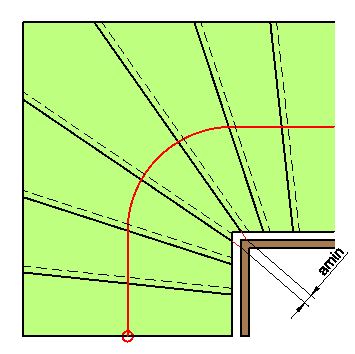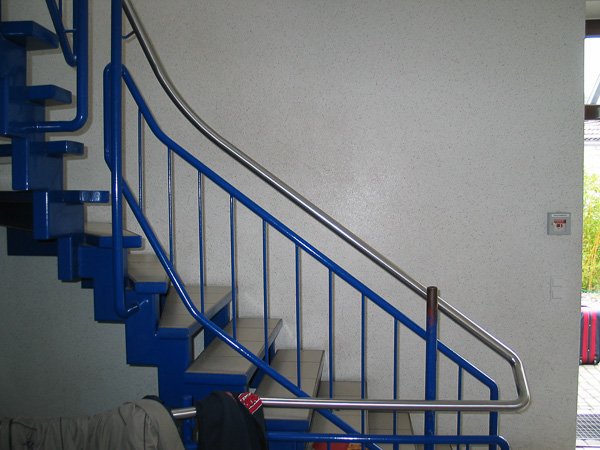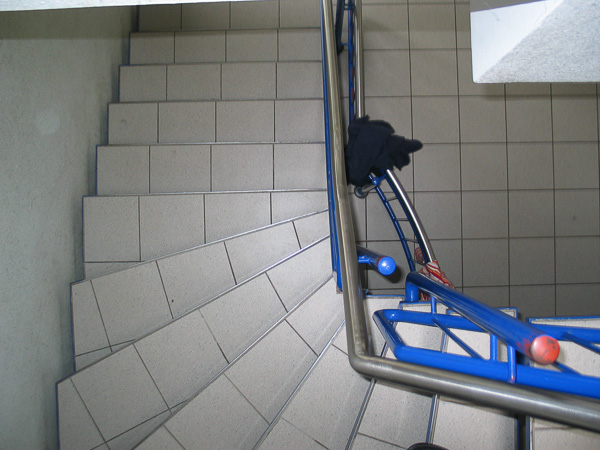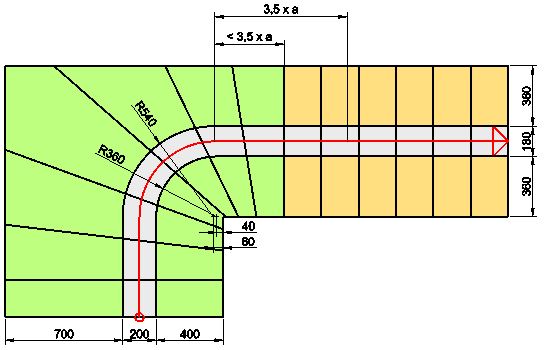
Normative specifications and limits for the safe and functional winding of stair steps.
See how fast it worksThe classical winding methods are very old and represent a geometric method of winding steps. They are independent of any standard. The current DIN 18065 standard contains requirements that winding must meet, so you need to consider these before the geometric construction.
Similar to the "correct" tread in the walking area, the minimum tread is measured as a chord at the inner boundary of the usable walking width. This means not necessarily at the inner step edge, but e.g. at the inner side of the handrail!
In the corner, the "short path" is taken as shown in the figure.

| Buildings in general | Residential buildings with up to 2 apartments and within apartments |
|---|---|
|
Standard stairs: 100 mm Spiral stairs: 100 mm |
Standard stairs: 50 mm Spiral stairs: 0 mm |
The tread of winded steps on the narrow side must decrease or remain constant toward the corner, according to the standard. That seems obvious, right? Unfortunately, practice shows that not every stair builder is aware of this:

The side view already suggests something serious. And that in a public building!

The top view confirms it. The first winded step is far too strongly wound and has a smaller minimum tread than the following one.
For the first time, the standard regulates the number of winded steps. This is done indirectly, in that in the straight section of a run starting from the corner, winded steps may be arranged over a maximum length of 3.5 x a. Here is what it looks like:

The purpose of this regulation is to prevent the occasionally encountered stairs with only winded steps, which increase the risk of accidents.
According to the standard, this regulation does not need to be observed if the staircase has been wound using a craftsmanship-approved winding method.
This exception is likely due to bolt stairs, where "full winding" is used for structural reasons. Unfortunately, this vaguely worded exception undermines the well-intentioned regulation, because ultimately all stairs are wound according to certain rules, and even the lath method is described in the literature and essentially means "trial and error".
The standard states that different winding methods cannot be applied within one stair flight. A staircase with two quarter-turns, for example, has two areas that are wound independently of each other.
This regulation too must be critically assessed in its general formulation. For stairs with multiple corners (i.e., winding areas), a harmonious winding can often only be achieved using different methods, e.g. with short entry or exit sections.
Since 2011, Austria has had a new standard in which the treads of winded stairs are considered in a completely new way: instead of measuring the tread as a chord, circles with d = a are now placed between the steps so that the step front edges form tangents and the circle center lies on the walking line. As a result, the steps have a larger tread where the walking line forms an arc, compared to the conventional approach.
Unfortunately, this approach is not compatible with previous winding methods and is also hardly feasible structurally except through imprecise trial and error: the position of the step edges results from their angle, and the angle results from the position. So in Austria, the cat is chasing its own tail.